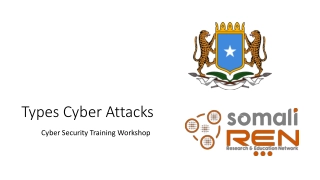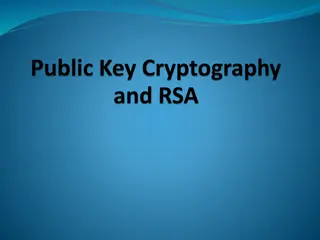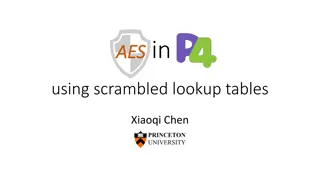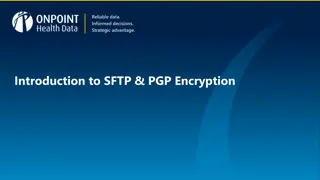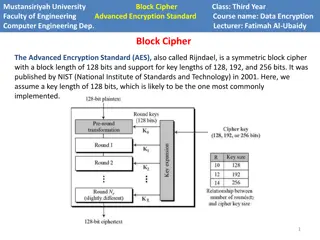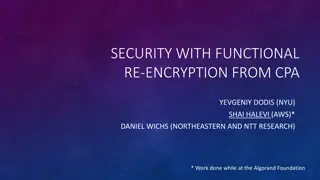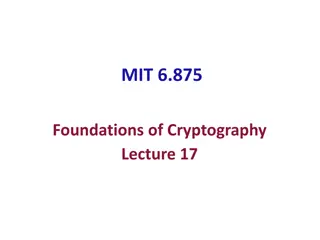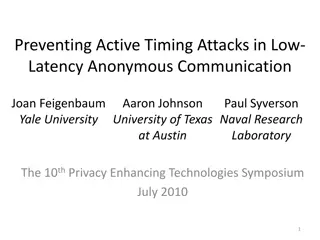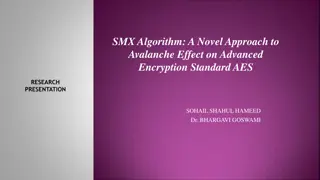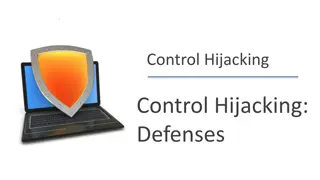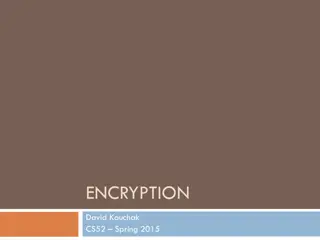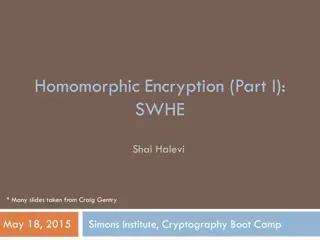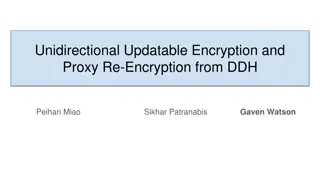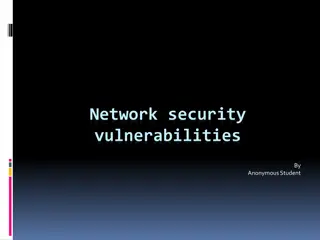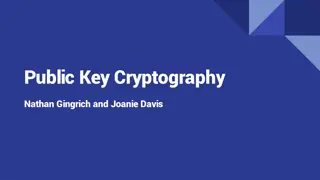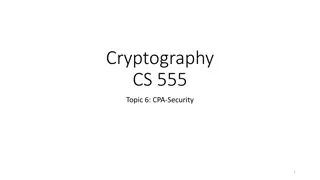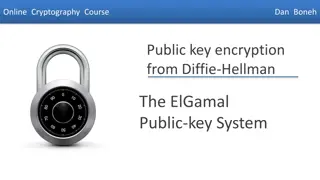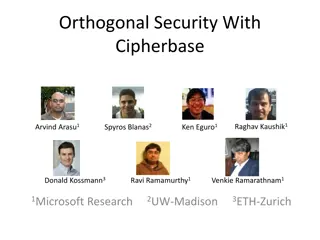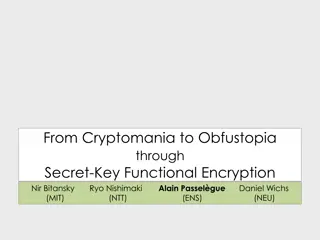Active Attacks on CPA-Secure Encryption by Dan Boneh
This course by Dan Boneh discusses authenticated encryption and active attacks on CPA-secure encryption. Dive into the intricacies of cryptography with a focus on practical application and security measures. Learn from a renowned expert in the field in an engaging and informative manner.
Download Presentation

Please find below an Image/Link to download the presentation.
The content on the website is provided AS IS for your information and personal use only. It may not be sold, licensed, or shared on other websites without obtaining consent from the author.If you encounter any issues during the download, it is possible that the publisher has removed the file from their server.
You are allowed to download the files provided on this website for personal or commercial use, subject to the condition that they are used lawfully. All files are the property of their respective owners.
The content on the website is provided AS IS for your information and personal use only. It may not be sold, licensed, or shared on other websites without obtaining consent from the author.
E N D
Presentation Transcript
Online Cryptography Course Dan Boneh Authenticated Encryption Active attacks on CPA-secure encryption Dan Boneh
Recap: the story so far Confidentiality: semantic security against a CPA attack Encryption secure against eavesdropping only Integrity: Existential unforgeability under a chosen message attack CBC-MAC, HMAC, PMAC, CW-MAC This module: encryption secure against tampering Ensuring both confidentiality and integrity Dan Boneh
Sample tampering attacks TCP/IP: (highly abstracted) WWW port = 80 packet dest = 80 data source machine TCP/IP stack Bob port = 25 destination machine Dan Boneh
Sample tampering attacks IPsec: (highly abstracted) WWW port = 80 TCP/IP stack packet dest = 80 data dest = 25 stuff k k Bob packets encrypted using key k port = 25 Dan Boneh
Reading someone elses data Note: attacker obtains decryption of any ciphertext beginning with dest=25 WWW port = 80 IV, dest = 80 data Bob: IV , k dest = 25 data k Bob Easy to do for CBC with rand. IV port = 25 (only IV is changed) Dan Boneh
IV , IV , dest = 80 data dest = 25 data Encryption is done with CBC with a random IV. m[0] = D(k, c[0]) IV = dest=80 What should IV be? IV = IV ( 25 ) IV = IV ( 80 ) IV = IV ( 80 ) ( 25 ) It can t be done
An attack using only network access Remote terminal app.: each keystroke encrypted with CTR mode TCP/IP packet k D T IP hdr TCP hdr 16 bit TCP checksum 1 byte keystroke k IP hdr TCP hdr t s for all t, s send: ACK if valid checksum, nothing otherwise { checksum(hdr, D) = t checksum(hdr, D s) } can find D Dan Boneh
The lesson CPA security cannot guarantee secrecy under active attacks. Only use one of two modes: If message needs integrity but no confidentiality: use a MAC If message needs both integrity and confidentiality: use authenticated encryption modes (this module) Dan Boneh
End of Segment Dan Boneh
Online Cryptography Course Dan Boneh Authenticated Encryption Definitions Dan Boneh
Goals An authenticated encryption system (E,D) is a cipher where As usual: E: K M N C but D: K C N M { } ciphertext is rejected Security: the system must provide sem. security under a CPA attack, and ciphertext integrity: attacker cannot create new ciphertexts that decrypt properly Dan Boneh
Ciphertext integrity Let (E,D) be a cipher with message space M. m1 M c1 E(k,m1) m2, , mq c2 , , cq Chal. k K Adv. c b b=1 if D(k,c) and c { c1, , cq } b=0 otherwise Def: (E,D) has ciphertext integrity if for all efficient A: AdvCI[A,E] = Pr[Chal. outputs 1]is negligible. Dan Boneh
Authenticated encryption Def: cipher (E,D) provides authenticated encryption (AE) if it is (1) semantically secure under CPA, and (2) has ciphertext integrity Bad example: CBC with rand. IV does not provide AE D(k, ) never outputs , hence adv. easily wins CI game Dan Boneh
Implication 1: authenticity Attacker cannot fool Bob into thinking a message was sent from Alice m1 , , mq c Bob Alice ci = E(k, mi) k k Cannot create valid c { c1, , cq } if D(k,c) Bob knows message is from someone who knows k (but message could be a replay) Dan Boneh
Implication 2 Authenticated encryption Security against chosen ciphertext attacks (next segment) Dan Boneh
End of Segment Dan Boneh
Online Cryptography Course Dan Boneh Authenticated Encryption Chosen ciphertext attacks Dan Boneh
Example chosen ciphertext attacks Adversary has ciphertext c that it wants to decrypt Often, adv. can fool server into decrypting certain ciphertexts (not c) dest = 25 data data Often, adversary can learn partial information about plaintext TCP/IP packet ACK if valid checksum Dan Boneh
Chosen ciphertext security Adversary s power: both CPA and CCA Can obtain the encryption of arbitrary messages of his choice Can decrypt any ciphertext of his choice, other than challenge (conservative modeling of real life) Adversary s goal: Break sematic security Dan Boneh
Chosen ciphertext security: definition E = (E,D) cipher defined over (K,M,C). For b=0,1 define EXP(b): for i=1, ,q: Chal. Adv. b (1) CPA query: k K mi,0 , mi,1 M : |mi,0| = |mi,1| ci E(k, mi,b) (2) CCA query: ci C : ci {c1, , ci-1} mi D(k, ci) b {0,1} Dan Boneh
Chosen ciphertext security: definition E is CCA secure if for all efficient A: AdvCCA [A,E] = |Pr[EXP(0)=1] Pr[EXP(1)=1] | is negligible. Example: CBC with rand. IV is not CCA-secure m0 , m1 : c E(k, mb) = (IV, c[0]) |m0| = |m1|=1 Chal. Adv. b k K c = (IV 1, c[0]) b D(k,c ) = mb 1 Dan Boneh
Authenticated enc. CCA security Thm: Let (E,D) be a cipher that provides AE. Then (E,D) is CCA secure ! In particular, for any q-query eff. A there exist eff. B1, B2 s.t. AdvCCA[A,E] 2q AdvCI[B1,E] + AdvCPA[B2,E] Dan Boneh
Proof by pictures Chal. Adv. Chal. Adv. CPA query: mi,0 , mi,1 CPA query: mi,0 , mi,1 ci=E(k,mi,0) ci=E(k,mi,0) k K k K p CCA query: ci CCA query: ci D(k,ci) p p Chal. Adv. Chal. Adv. CPA query: mi,0 , mi,1 CPA query: mi,0 , mi,1 ci=E(k,mi,1) ci=E(k,mi,1) p k K k K CCA query: ci CCA query: ci D(k,ci) Dan Boneh
So what? Authenticated encryption: ensures confidentiality against an active adversary that can decrypt some ciphertexts Limitations: does not prevent replay attacks does not account for side channels (timing) Dan Boneh
End of Segment Dan Boneh
Online Cryptography Course Dan Boneh Authenticated Encryption Constructions from ciphers and MACs Dan Boneh
but first, some history Authenticated Encryption (AE): introduced in 2000 [KY 00, BN 00] Crypto APIs before then: (e.g. MS-CAPI) Provide API for CPA-secure encryption (e.g. CBC with rand. IV) Provide API for MAC (e.g. HMAC) Every project had to combine the two itself without a well defined goal Not all combinations provide AE Dan Boneh
Combining MAC and ENC (CCA) Encryption key kE. MAC key = kI Option 1: (SSL) S(kI, m) E(kE , mlltag) tag msg m msg m Option 2: (IPsec) always correct S(kI, c) E(kE, m) tag msg m Option 3: (SSH) S(kI, m) E(kE , m) tag msg m Dan Boneh
A.E. Theorems Let (E,D) be CPA secure cipher and (S,V) secure MAC. Then: 1. Encrypt-then-MAC: always provides A.E. 2. MAC-then-encrypt: may be insecure against CCA attacks however: when (E,D) is rand-CTR mode or rand-CBC M-then-E provides A.E. for rand-CTR mode, one-time MAC is sufficient Dan Boneh
Standards (at a high level) GCM: CTR mode encryption then CW-MAC (accelerated via Intel s PCLMULQDQ instruction) CCM: CBC-MAC then CTR mode encryption (802.11i) EAX: CTR mode encryption then CMAC All support AEAD: (auth. enc. with associated data). All are nonce-based. encrypted associated data encrypted data authenticated Dan Boneh
An example API (OpenSSL) int AES_GCM_Init(AES_GCM_CTX *ain, unsigned char *nonce, unsigned long noncelen, unsigned char *key, unsigned int klen ) int AES_GCM_EncryptUpdate(AES_GCM_CTX *a, unsigned char *aad, unsigned long aadlen, unsigned char *data, unsigned long datalen, unsigned char *out, unsigned long *outlen) Dan Boneh
MAC Security -- an explanation Recall: MAC security implies (m , t) (m , t ) Why? Suppose not: (m , t) (m , t ) Then Encrypt-then-MAC would not have Ciphertext Integrity !! m0, m1 Chal. Adv. (c0, t) c E(k, mb) = (c0, t) b k K c = (c0, t ) c b (c0, t ) D(k,c ) = mb Dan Boneh
OCB: a direct construction from a PRP More efficient authenticated encryption: one E() op. per block. checksum m[0] m[1] m[2] m[3] P(N,k,0) P(N,k,1) P(N,k,2) P(N,k,3) P(N,k,0) E(k, ) E(k, ) E(k, ) E(k, ) E(k, ) P(N,k,3) auth P(N,k,0) P(N,k,1) P(N,k,2) c[0] c[1] c[2] c[3] c[4] Dan Boneh
Performance: Crypto++ 5.6.0 [ Wei Dai ] AMD Opteron, 2.2 GHz ( Linux) code size Speed (MB/sec) Cipher large ** AES/GCM 108 AES/CTR 139 AES/CCM smaller 61 AES/CBC 109 AES/EAX smaller 61 AES/CMAC 109 129* AES/OCB HMAC/SHA1 147 * extrapolated from Ted Kravitz s results ** non-Intel machines Dan Boneh
End of Segment Dan Boneh
Online Cryptography Course Dan Boneh Authenticated Encryption Case study: TLS Dan Boneh
The TLS Record Protocol (TLS 1.2) HDR TLS record kb s, ks b kb s, ks b Unidirectional keys: kb sand ks b Stateful encryption: Each side maintains two 64-bit counters: ctrb s, ctrs b Init. to 0 when session started. ctr++ for every record. Purpose: replay defense Dan Boneh
TLS record: encryption (CBC AES-128, HMAC-SHA1) type ll ver ll len kb s = (kmac , kenc) data tag pad Browser side enc(kb s , data, ctrb s) : step 1: tag S( kmac , [ ++ctrb sll header ll data]) step 2: pad [ header ll data ll tag ] to AES block size step 3: CBC encrypt with kenc andnew random IV step 4: prepend header Dan Boneh
TLS record: decryption (CBC AES-128, HMAC-SHA1) Server side dec(kb s , record, ctrb s) : step 1: CBC decrypt record using kenc step 2: check pad format: send bad_record_mac if invalid step 3: check tag on [ ++ctrb sll header ll data] send bad_record_mac if invalid Provides authenticated encryption (provided no other info. is leaked during decryption) Dan Boneh
Bugs in older versions (prior to TLS 1.1) IV for CBC is predictable: (chained IV) IV for next record is last ciphertext block of current record. Not CPA secure. (a practical exploit: BEAST attack) Padding oracle: during decryption if pad is invalid send decryption failed alert if mac is invalid send bad_record_mac alert attacker learns info. about plaintext (attack in next segment) Lesson: when decryption fails, do not explain why Dan Boneh
Leaking the length The TLS header leaks the length of TLS records Lengths can also be inferred by observing network traffic For many web applications, leaking lengths reveals sensitive info: In tax preparation sites, lengths indicate the type of return being filed which leaks information about the user s income In healthcare sites, lengths leaks what page the user is viewing In Google maps, lengths leaks the location being requested No easy solution Dan Boneh
802.11b WEP: how not to do it 802.11b WEP: m CRC(m) k PRG( IV ll k ) k ciphetext IV Previously discussed problems: two time pad and related PRG seeds Dan Boneh
Active attacks Fact: CRC is linear, i.e. m,p: CRC( m p) = CRC(m) F(p) WEP ciphertext: attacker: IV dest-port = 80 data CRC 000 .00 ..XX 0000 F(XX) XX = 25 80 dest-port = 25 data CRC IV Upon decryption: CRC is valid, but ciphertext is changed !! Dan Boneh
End of Segment Dan Boneh
Online Cryptography Course Dan Boneh Authenticated Encryption CBC paddings attacks Dan Boneh
Recap Authenticated encryption: CPA security + ciphertext integrity Confidentiality in presence of active adversary Prevents chosen-ciphertext attacks Limitation: cannot help bad implementations (this segment) Authenticated encryption modes: Standards: GCM, CCM, EAX General construction: encrypt-then-MAC Dan Boneh
The TLS record protocol (CBC encryption) Decryption: dec(kb s , record, ctrb s) : step 1: CBC decrypt record using kenc step 2: check pad format: abort if invalid step 3: check tag on [ ++ctrb sll header ll data] abort if invalid type ll ver ll len Two types of error: padding error MAC error data tag pad Dan Boneh
Padding oracle Suppose attacker can differentiate the two errors (pad error, MAC error): Padding oracle: attacker submits ciphertext and learns if last bytes of plaintext are a valid pad type ll ver ll len data Nice example of a chosen ciphertext attack tag pad Dan Boneh
Padding oracle via timing OpenSSL Credit: Brice Canvel (fixed in OpenSSL 0.9.7a) In older TLS 1.0: padding oracle due to different alert messages. Dan Boneh
Using a padding oracle (CBC encryption) Attacker has ciphertext c = (c[0], c[1], c[2]) and it wants m[1] IV c[0] c[1] c[2] D(k, ) D(k, ) D(k, ) m[2] ll pad m[0] m[1] Dan Boneh


